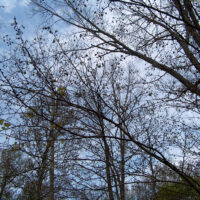 Purdue University - Extension - Forestry and Natural Resources
Purdue University - Extension - Forestry and Natural Resources
Got Nature? Blog
 In particular, newly fall-planted trees, shrubs, and perennials should be monitored and watered late into the season, since they haven’t had time to develop extensive root systems.
In particular, newly fall-planted trees, shrubs, and perennials should be monitored and watered late into the season, since they haven’t had time to develop extensive root systems.
Pay attention to evergreens plants. Evergreens do not go dormant in the winter and are still actively respiring and lose water through their needles. Deciduous trees respire at lower rates in winter.
Since soil insulates and cools down later in the year than the air temperature, roots stay warmer longer and respire at higher rates than the above-ground parts, the trunk, and branches, of deciduous trees after their leaves drop.
Only water when the temperature is above 40°F. In some places, that could be as late as the end of December. That last good watering is an important one.
Stop supplemental watering after the ground freezes because at this point the trees cannot absorb water through the frozen soil.
Other Helpful Resources:
Winterize Your Trees, The Education Store, Purdue Extension’s resource center
Why are the Gingko Leaves Not Falling, Purdue Extension-Forestry and Natural Resources Got Nature? Blog
ID That Tree Winter Edition: Alternate Leaf Arrangement – Black Walnut/Eastern Cottonwood, FNR Got Nature? Blog
ID That Tree Winter Edition: Opposite Leaf Arrangement – Ohio Buckeye/Red Maple, Purdue Extension-FNR YouTube Channel
ID That Tree Winter Edition: Alternate Leaf Arrangement – Honey Locust/Burr Oak, Purdue Extension-FNR YouTube Channel
How do Trees Use Water?, Purdue Landscape Report
Planting Your Tree Part 1: Choosing Your Tree, Purdue extension-FNR YouTube Channel
Tree Installation: Process and Practices, The Education Store
Lindsey Purcell, Chapter Executive Director
Indiana Arborist Association

Recent Posts
- Report Spotted Lanternfly – Purdue Landscape Report
Posted: April 10, 2024 in Alert, Forestry, Invasive Insects, Plants, Wildlife, Woodlands - Declining Pines of the White Variety – Purdue Landscape Report
Posted: in Alert, Disease, Forestry, Plants, Wildlife, Woodlands - Are you seeing nests of our state endangered swan? – Wild Bulletin
Posted: April 9, 2024 in Alert, Forestry, How To, Wildlife - Cicadas in Spring! – Purdue Landscape Report
Posted: in Forestry, Plants, Safety, Wildlife - New Deer Impact Toolbox
Posted: April 7, 2024 in Forestry, Land Use, Plants, Publication, Safety, Wildlife, Woodlands - 2024-25 Fishing Guide now available – Wild Bulletin
Posted: April 4, 2024 in Alert, Aquaculture/Fish, Aquatic/Aquaculture Resources, How To, Ponds, Wildlife - Help Research Chronic Wasting Disease – Wild Bulletin
Posted: April 3, 2024 in Disease, Forestry, How To, Safety, Wildlife, Woodlands - Indiana Reptiles and Amphibians – IFWOA Webinar
Posted: April 1, 2024 in Forestry, How To, Webinar, Wildlife, Woodlands - Birding through the Seasons – IFWOA Webinar
Posted: in Forestry, How To, Webinar, Wildlife, Woodlands - Look Out for Invasive Carp in Your Bait Bucket – Wild Bulletin
Posted: March 31, 2024 in Alert, Aquaculture/Fish, Aquatic/Aquaculture Resources, Invasive Animal Species, Wildlife
Archives
Categories
- Alert
- Aquaculture/Fish
- Aquatic/Aquaculture Resources
- Ask the Expert
- Christmas Trees
- Community Development
- Disease
- Drought
- Forestry
- Forests and Street Trees
- Gardening
- Got Nature for Kids
- Great Lakes
- How To
- Invasive Animal Species
- Invasive Insects
- Invasive Plant Species
- Land Use
- Natural Resource Planning
- Nature of Teaching
- Plants
- Podcasts
- Ponds
- Publication
- Safety
- Timber Marketing
- Uncategorized
- Urban Forestry
- Webinar
- Wildlife
- Wood Products/Manufacturing
- Woodland Management Moment
- Woodlands